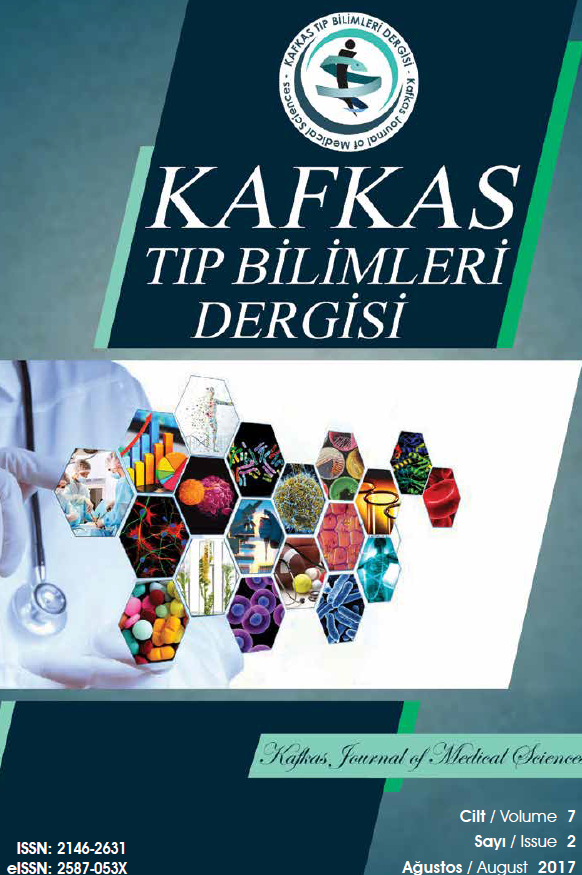Behçet Üveitli Hastalarda HLA-B*51 Alt Tipinin Değerlendirilmesi
Behçet hastalığı, üveit, allel, HLA-B*51, PCR-SSP
Evaluation of HLA-B*51 Subtypes in Behçet's Patients with Uveitis
Behçet’s disease, uveitis, allele, HLA-B*51, PCR-SSP,
___
- 1. Sakane T, Takeno M, Suzuki N. Behçet’s disease. New Eng J Med, 1999;17:1284–1291.
- 2. Öztaş P, Polat M, Gür G, et al. The etiopathogenesis of Behcet’s disease. Tr Klin J Dermatol 2006;16:181–5.
- 3. Al-Otaibi LM, Porter SR, Poate TW. Behçet’s disease: a review. J Dent Res 2005;84.:209–22.
- 4. Alpsoy E. Behçet Disease An Update in Ethiopathogenesis Tr J Dermatol 2013;7:41–5.
- 5. Chang HK, Kim JU, Cheon KS, Chung HR. K. W. Lee5, I. H. Lee HLA-B51 and its allelic types in association with Behcet’s disease and recurrent aphthous stomatitis in Korea Clin Exp Rheumatol 2001;19/24:31–35.
- 6. Gül A. Behcet’s disease: An update on the Pathogenesis. Clin Exp Rheumatol 22001;19/24:6–12. S6-S12.
- 7. Kera J, Mizuki N, Ota M; Significant associations ofHLA-B*5101 and B*5108, and lack of association of classII alleles with Behcet’s disease in Italian patients. Tissue Antigens 1999;54(6):565–571.
- 8. Paul M, Klein T, Krause I. Allelic distribution of HLAB*5 in HLA-B5-positive Israeli patients with Behcet’s disease. Tissue Antigens 2001;58(3):185–186.
- 9. Gul A, Ohno S. HLA-B*51 and Behçet Disease Ocular Imminol inflame, 12/2011;20(1):37–43.
- 10. Gonzalez-Escribano MF, Rodriguez MR, Walter K. Association of HLA-B51 subtypes and Behcet’s disease inSpain. Tissue Antigens 1998;52(1):78–80.
- 11. Yabuki K, Ohno S, Mizuki N. HLA class I and II typing of the patients with Behcet’s disease in Saudi Arabia. Tissue Antigens 1999;54(3):273–277.
- 12. Kotter I, Gunaydin I, Stubiger N. Comparative analysis of the association of HLA-B*51 suballeles with Behcet’s disease in patients of German and Turkish origin. Tissue Antigens 2001;58(3):166–170.
- 13. Mizuki N, Ota M, Katsuyama Y. Sequencing-basedtyping of HLA-B*51 alleles and the significant associationof HLA-B*5101 and -B*5108 with Behcet’s disease in Greekpatients. Tissue Antigens 2002;59(2):118–121.
- 14. Pirim I, Atasoy M, Ikbal M. HLA class I and class IIgenotyping in patients with Behcet’s disease: a regional study of eastern part of Turkey. Tissue Antigens, 2004;64(3):293–297.
- 15. Gul A, Uyar FA, Inanc M, Ocal L, Barrett JH, Aral O. A weak association of HLA-B*2702 with Behcet’s disease. Genes Immune 2002;3:368–72.
- 16. Petrushkin H, Hasan S, Stanford MR. Behçet’s disease: do natural killer cells play a significant role Front Immunol 2015;6:134.
- 17. Kaya TJ. Genetics of Behçet’s Disease. Pathol Res Int 2012;6:1–6.
- 18. Middleton D, Meenagh A, Sleator C. No association of KIR genes with Behcet’s disease. Tissue Antigens, 2007;70:435–438.
- 19. Mizuki N, Ota M, Katsuyam Y, Yabuki K. Association analaysis between the MIC-A and HLA-B alleles in Japanase patients with Behçet’s disease. Arthr Rheumat 1999;42:1961–1966.
- 20. Davatchi, F. Shahram, A. Nadji, S. Soroosh, A. R. Jamshidi, C. Chams, H. Chams, M Akbarian, . F. Gharibdoost, M. Acta Medica Iranica 2008;46(6):507–510.
- 21. Kang EH, Kim JY, Takeuchi F. Associations between the HLA-A polymorphism and the clinical manifestations of Behcet’s disease. Arthritis Res Ther 2011;13(2):49.
- 22. Akman A, Alpsoy E. Behcet’s Disease: Current Aspects in the Etiopathogenesis. Tr Dermato, 2009;43:2:32–8.
- 23. Demirseren DD, Ceylan GG, Akoglu G. HLA-B51 subtypes in Turkish patients with Behçet’s disease and their correlation with clinical manifestations. Gen Mol Re, 2014;13(3):4788–4796.
- 24. Suzuki KM, Suzuki N. Behçet’s disease. Clin Exp Med 2004;4:10–20.
- 25. Azizlerli G, Kose AA, Sarica R, Gul A. Prevalence of Behçet’s disease in Istanbul, Turkey. Int. J Dermatol 2003;42:803–806.
- 26. Varol A, Seifert O, Anderson CD. The skin pathergy test: innately useful. Arch Dermatol Res 2010;302:155–158.
- 27. Maldini C, LaValley MP, Cheminant M. Relationships of HLA-B51 or B5 genotype with Behcet’s disease clinical characteristics: systematic review and meta-analyses of observational studies. Rheumatol 2012;51:887–900.
- 28. Pickering MC, Haskard DO. Behcet’s Syndrome. J Royal Coll Phys 2000;34(2):169–177.
- 29. Evereklioglu C. Current concepts in the etiology and treatment of Behçet disease. Surv Ophthalmol 2005;50(4):297–350.
- 30. Mizuki N, Inoko H, Ohno S. Pathogenic gene responsiblefor the predisposition of Behcet’s disease. Int Rev Immunol 1997;14:33 48.
- 31. Takemoto Y, Naruse T, Namba K, Kitaichi N, Ota M, Shindo Y, Mizuki N, . Re-evaluation of heterogeneity in HLA-B*510101 associated with Behçet’s disease. Tissue Antigens 2008 72(4):347–53.
- 32. Direskeneli H. Behçet’s disease: infectious aetiology, new autoantigens, and HLA-B51. Ann Rheum Dis 2001;60:996– 1002.
- ISSN: 2146-2631
- Yayın Aralığı: Yılda 3 Sayı
- Başlangıç: 2011
- Yayıncı: Kafkas Üniversitesi
Yumuşak Damak Yerleşimli Epitelyal-Myoepitelyal Karsinom Olgusu
Ülkü KÜÇÜK, Emel Ebru PALA, Ebru ÇAKIR, Sümeyye EKMEKÇİ, Samir ABDULLAZADE, Pınar ÖKSÜZ, Anıl HIŞMİ
Canan ÇELEBİ, Volkan SOLMAZ, Yağmur İNALKAÇ, Yahya ÇELİK
Mehmet Fatih ÜSTÜNDAĞ, Halil ÖZCAN, Ece YAZLA, Yüksel KIVRAK, Esat Fahri AYDİN, Mehmet YILMAZ
Kemal Özgür DEMİRALP, Onur ŞAHİN, Emine Şebnem Kurşun ÇAKMAK, Seval BAYRAK
Künt Minör Toraks Travması: Acil Servise Başvuran 186 Hastanın Prospektif Analizi
Faruk GÜNGÖR, Kamil Can AKYOL, Taylan KILIÇ, Mustafa KEŞAPLI, Asım ARI, Ali Vefa SAYRAÇ
Kars’da Gelişimsel Kalça Displazi Tarama Sonuçları ve Ortalama Maliyet Analizi
Ali BİLGE, Gökhan Ragıp ULUSOY, Bilgehan ÇATAL, Sefer ÜSTEBAY, Döndü ÜSTEBAY
Künt Travma Sonrası Pnömotorakssız Pnömoperitoneum
Mesut YUR, Mehmet ŞİRİK, Cengiz Ömer ÖZDEMİR
Karpal Tünel Sendromunda Kortikosteroid Enjeksiyonu, Fonoforez ve İyontoforezin Karşılaştırılması
Kudret Cem KARAYOL, Ece ÜNLÜ, Aytül ÇAKICI
Acil Servise Başvuran Geriatrik Hastaların Cinsiyete Göre Değerlendirilmesi
